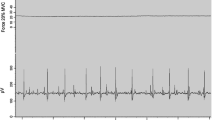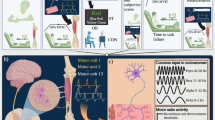Abstract
A common belief in exercise physiology is that fatigue during exercise is caused by changes in skeletal muscle metabolism. This ‘periphera’ fatigue results either from substrate depletion during submaximal exercise or metabolite accumulation during maximal exercise in the exercising muscles. However, if substrate depletion alone caused fatigue, intracellular ATP levels would decrease and lead to rigor and cellular death. Alternatively, metabolite accumulation would prevent any increase in exercise intensity near the end of exercise. At present, neither of these effects has been shown to occur, which suggests that fatigue may be controlled by changes in efferent neural command, generally described as ‘central’ fatigue.
In this review, we examine neural efferent command mechanisms involved in fatigue, including the concepts of muscle wisdom during short term maximal activity, and muscle unit rotation and teleoanticipation during submaximal endurance activity. We propose that neural strategies exist to maintain muscle reserve, and inhibit exercise activity before any irreparable damage to muscles and organs occurs. The finding that symptoms of fatigue occur in the nonexercising state in individuals with chronic fatigue syndrome indicates that fatigue is probably not a physiological entity, but rather a sensory manifestation of these neural regulatory mechanisms.







Similar content being viewed by others
References
Gandevia SC, Enoka RM, McComas AJ, et al. Neurobiology of muscle fatigue - advances and issues. In: Gandevia SC, editor. Fatigue. New York: Plenum Press, 1995; 515–25
Hagberg M. Muscular endurance and surface electromyogram in isometric and dynamic exercise. J Appl Physiol 1981; 51: 1–7
Hawley JA, Reilly T. Fatigue revisited. J Sports Sci 1997; 15: 245–6
Bigland-Ritchie B. EMG/Force relations and fatigue of human voluntary contractions. Exerc Sports Sci Rev 1981; 9: 75–117
Enoka, RM, Stuart DG. Neurobiology of muscle fatigue. J Appl Physiol 1992; 72: 1631–48
Hakkinen K, Komi PV. Electromyographic and mechanical characteristics of human skeletal muscle during fatigue under voluntary and reflex conditions. Electroencephalogr Clin Neurophysiol 1983; 55: 436–44
Taylor AD, Brooks R, Smith P, et al. Myoelectric evidence of peripheral muscle fatigue during exercise in severe hypoxia: some references to m. vastus lateralis myosin heavy chain composition. Eur J Appl Physiol 1997; 75: 151–9
Fitts RH. Cellular mechanisms of muscle fatigue. Physiol Rev 1994; 74: 49–94
Green H. Mechanisms of muscle fatigue in intense exercise. J Sports Sci 1997; 15: 247–56
Greenhaff PL, Timmons JA. Pyruvate dehydrogenase complex activation status and acetyl group availability as a site of interchange between anaerobic and oxidative metabolism during intense exercise. Adv Exp Med Biol 1998; 441: 287–98
Korge P. Factors limiting adenosine triphosphatase function during high intensity exercise: thermodynamic and regulatory considerations. Sports Med 1995; 20 (4): 215–25
Noakes TD. Physiological models to understand exercise fatigue and the adaptations that predict or enhance athletic performance. Scand J Med Sci Sports 2000; 10: 123–45
Spriet LL, Soderland K, Bergstrom M, et al. Anaerobic energy release in skeletal muscle metabolism during electrical stimulation in men. J Appl Physiol 1987; 62: 611–5
Sargeant AJ. Human power output and muscle fatigue. Int J Sports Med 1994; 15: 116–21
Wagenmakers AJ. Role of amino acids and ammonia in mechanisms of fatigue. In: Marconnet P, Komi PV, Saltin B, et al., editors. Muscle fatigue mechanisms in exercise and training. Vol. 34. Medicine and sport science. Basel: Karger, 1992: 69–86
Windhorst U, Boorman G. Overview: potential role of segmental motor circuitry in muscle fatigue. In: Gandevia SC, editor. Fatigue. New York: Plenum Press, 1995: 241–58
Basmajian JV, DeLuca CJ. Muscles alive — their function revealed by electromyography. Baltimore (MD): Williams and Wilkins, 1985
Bigland-Ritchie B. Changes in muscle contractile properties and neural control during human muscular fatigue. Muscle Nerve 1984; 7: 691–9
Jones DA. High- and low-frequency fatigue revisited. Acta Physiol Scand 1996; 156: 265–70
Jones DA, Bigland-Ritchie B, Edwards RHT. Excitation frequency and muscle fatigue:mechanical responses during voluntary and stimulated contractions. Exp Neurol 1979; 64: 401–13
Binder-Macleod SA, Guerin T. Preservation of force output through progressively reduction of stimulation frequency in human quadriceps femoris muscle. Phys Ther 1990; 70: 619–25
Binder-Macleod SA, McDermond LR. Changes in the force frequency relationship of the human quadriceps femoris muscle following electrically and voluntarily induced fatigue. Phys Ther 1992; 72: 95–104
Westgaard RH, De Luca CJ. Motor unit substitution in long duration contractions of the human trapezius muscle. J Neurophysiol 1999; 82: 501–4
De Luca CJ, Erim Z. Common motor drive in regulation of muscle force. Trends Neurosci 1994; 17: 299–305
Brody LR, Pollock MT, Roy SH, et al. pH-induced effects on median frequency and conduction velocity of the myoelectric signal. J Appl Physiol 1991; 71: 1878–85
Gerdle B, Karlsson S, Crenshaw AG, et al. The relationships between EMG and muscle morphology throughout sustained static knee extension at two submaximal force levels. Acta Physiol Scand 1997; 160: 341–51
Kupa EJ, Roy SH, Kandarian SC, et al. Effects of muscle fiber type and size on EMG median frequency and conduction velocity. J Appl Physiol 1995; 79: 23–32
Lowery MM, Vaughan CL, Nolan PJ, et al. Spectral compression of the electromyographic signal due to decreasing muscle fibre conduction velocity. IEEE Trans Rehabil Eng 2000; 8: 353–61
McComas AJ. Skeletal muscle - form and function. Champaign (IL): Human Kinetics, 1996
Taylor AD, Brooks R, Smith P, et al. Myolectric evidence of peripheral muscle fatigue during exercise in severe hypoxia: some references to m. vastus lateralis myosin heavy chain composition. Eur J Appl Physiol 1997; 75: 151–9
Belhaj-Sahif A, Fourment A, Maton B. Adaptation of the precentral cortical command to elbow muscle fatigue. Exp Brain Res 1996; 111: 405–16
Chasiotis D, Bergstrom M, Hultman E. ATP utilization and force during intermittent and continuous muscle contractions. J Appl Physiol 1987; 63: 167–74
Hawley JA, Hopkins WG. Aerobic glycolytic and aerobic lipolytic power systems: a new paradigm with implications for endurance and ultra endurance events. Sports Med 1995; 19 (4): 240–50
Bangsbo J, Graham TE, Kiens B, et al. Elevated muscle glycogen and anaerobic energy production during exhaustive exercise in man. J Physiol 1992; 451: 205–27
Gaitanos GC, Williams C, Boobis LH, et al. Human muscle metabolism during intermittent maximal exercise. J Appl Physiol 1993; 75: 712–9
Ulmer H-V. Concept of an extracellular regulation of muscular metabolic rate during heavy exercise in humans by psychophysiological feedback. Experentia 1996; 52: 416–20
Shephard RJ. Tests of maximal oxygen uptake: a critical review. Sports Med 1984; 1 (2): 99–124
Howley ET, Bassett DR, Welch HG. Criteria for maximal oxygen uptake: review and commentary. Med Sci Sports Exerc 1995; 27: 1292–301
Bassett DR, Howley ET. Maximal oxygen uptake: ‘classical’ versus ‘contemporary’ viewpoints. Med Sci Sports Exerc 1997; 29: 591–603
Noakes TD. Implications of exercise testing for prediction of athletic performance: a contemporary perspective. Med Sci Sports Exerc 1988; 20: 319–30
St Clair Gibson A, Broomhead S, Lambert MI, et al. Maximal oxygen uptake predicted from 20-m shuttle run and measured directly in runners and squash players. J Sports Sci 1998; 16: 331–5
Armstrong N, Welsman J, Winsley J. Is peak V̇O2 a maximal index of children’s aerobic fitness? Int J Sports Med 1966; 17: 356–9
Duncan GE, Howley ET, Johnson BN. Applicability of V̇O2max criteria: discontinuous versus continuous protocols. Med Sci Sports Exerc 1995; 27: 1292–301
Hochachka PW. The metabolic implications of intracellular circulation. Proc Natl Acad Sci 1999; 96: 233–9
Noakes TD. Challenging beliefs: ex Africa semper aliquid novi. Med Sci Sports Exerc 1997; 29: 571–90
Noakes TD. Maximal oxygen uptake: ‘classical’ versus ‘contemporary’ viewpoints: a rebuttal. Med Sci Sports Exerc 1998; 30: 1381–98
Sloninger MA, Cureton KJ, Prior RM, et al. Lower extremity muscle activation during horizontal and uphill running. J Appl Physiol 1997; 83: 2073–9
Kayser B, NariciM, Binzoni T, et al. Fatigue and exhaustion in chronic hypobaric hypoxia: influence of exercising muscle mass. J Appl Physiol 1994; 76: 634–40
Hochachka PW, Clark CM, Matheson GO, et al. Effects on regional brain metabolism of high-altitude hypoxia: a study of six US marines. Am J Physiol 1999; 277 (1 Pt 2): R314-R319
Costill DL, Bennett A, Branam G, et al. Glucose ingestion at rest and during prolonged exercise. J Appl Physiol 1973; 34: 764–9
Coggan AR, Coyle EF. Reversal of fatigue during prolonged exercise by carbohydrate infusion or ingestion. J Appl Physiol 1987; 63: 2388–95
Tsintzas O, Williams C, Boobish L, et al. Carbohydrate ingestion and single muscle fiber glycogen metabolism during prolonged running in men. J Appl Physiol 1996; 81: 801–9
Burke LM, Hawley JA, Schabort EJ, et al. Carbohydrate loading failed to improve 100-km cycling performance in a placebocontrolled trial. J Appl Physiol 1999; 88: 1284–90
Kay D, Marino FE, Cannon J, et al. Evidence for neuromuscular fatigue during cycling in warm humid conditions. Eur J Appl Physiol 2001; 84: 115–21
Nicol C, Komi PV, Marconnet P. Fatigue effects of marathon running on neuromuscular performance. Scand J Med Sci Sports 1991; 1: 18–24
Sacco P, Newberry R, McFadden L, et al. Depression of human electromyographic activity by fatigue in a synergistic muscle. Muscle Nerve 1997; 20 (6): 710–7
Sjogaard G. Force-velocity curve for bicycle work. In: Asmussen E, Jorgenson K, editors. Biomechanics. VI. Baltimore (MD): University Park Press, 1978: 33–9
St Clair Gibson A, Lambert MI, Collins M, et al. Chronic exercise activity and the fatigued athlete myopathic syndrome. Int Sport Med J 2000; 1 (3). Available from: URL: http://www.esportmed.com/ismj/ [Accessed 2001 May 28]
Acknowledgements
The Medical Research Council of South Africa, and the Harry Crossley Fund of the University of Cape Town provided funds for the studies described in this review.
This work was presented at a symposium on control mechanism in fatigue at the South African Sports Medicine Association Congress, Johannesburg, South Africa, 1999.
Author information
Authors and Affiliations
Corresponding author
Rights and permissions
About this article
Cite this article
St Clair Gibson, A., Lambert, M.I. & Noakes, T.D. Neural Control of Force Output During Maximal and Submaximal Exercise. Sports Med 31, 637–650 (2001). https://doi.org/10.2165/00007256-200131090-00001
Published:
Issue Date:
DOI: https://doi.org/10.2165/00007256-200131090-00001




